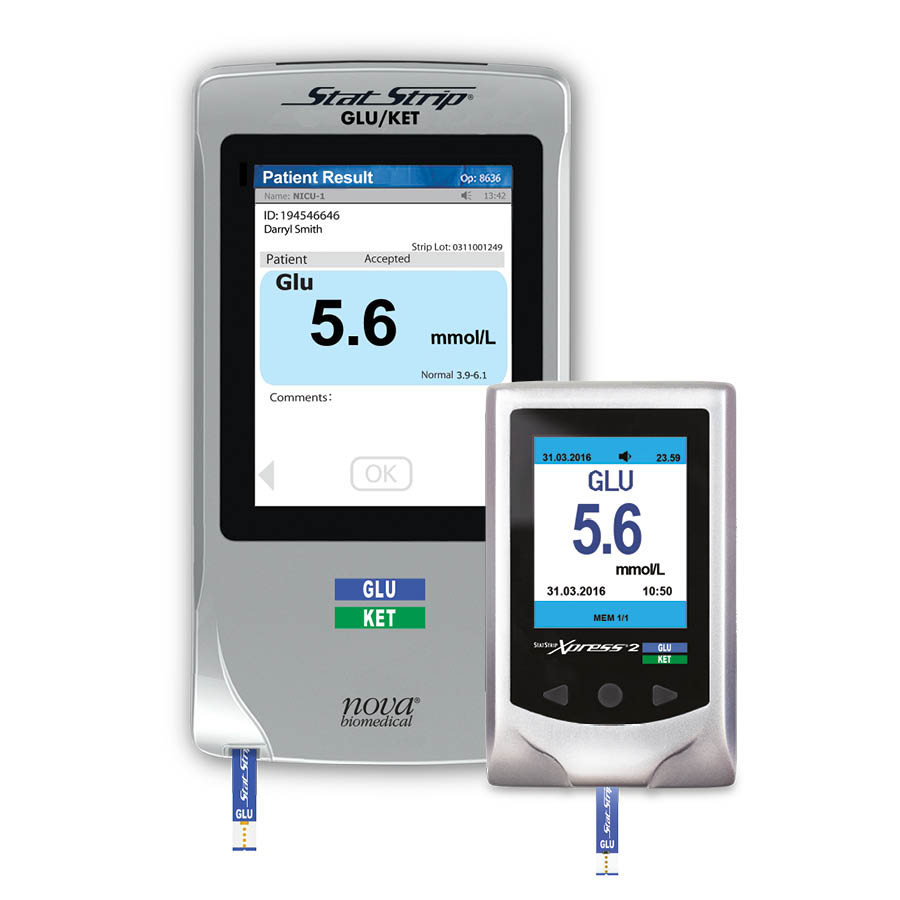Diabetic Keto Acidosis (DKA)
A life-threatening complication of poorly controlled type 1 and occasionally type 2 diabetes.
DKA is found in 65% of patients under 19-years old, it affects up to 40% of children at first diagnosis and 1,5% to 8% of diabetic children per year thereafter. It is the leading cause of death among children known to have diabetes, accounting for about 85% of such fatalities1.
- Based on 2003 data from the ADA
DKA is an extension of normal physiological mechanism that compensates for low glucose availability in cells.
In a state of low cellular glucose availability, the body changes from metabolism based on carbohydrate, to fat oxidation. Fatty acids are produced in adipocytes, and transported to the liver. They are broken down into ketone bodies (acetoacetate, acetone and beta-hydroxybutyrate) which are used as alternative fuel for cells. This state is called ketoacidosis.
Ketone bodies are acidic. During unrestrained ketosis, accumulation of larger amounts of ketones, combined with dehydration, can lower blood pH to dangerously acidic levels (pH<7.300).
According to ADA (American Diabetes Association), Diabetes UK, European Society for Pediatric Endocrinology and leading endocrinologists, blood ketone testing is an important part of patient monitoring during hyperglycemic events, glucose typically greater than 250 mg/dL (14mM) combined with elevated blood ketones indicate probable DKA.
Indications for ketone testing in the hospital include:
“all cases of hyperglycemia (glucose>250 mg/dL) in combination with an acute clinical condition: emergency situation, postoperative period, intensive care, major dehydration, oligo-anuria, etc.”1
“all cases of hyperglycemia when a diabetic patient is hospitalized.”2
- Guerci N et al. Advantage to using capillary blood B-hydroxybutyrate determination for the detection and treatment of diabetic ketosis. Diabetes & Metabolism, 2005.
- American Diabetes Acssociation. Tests of Glycemia in Diabetes. Diabetes Care 2004;27(Suppl.1).
Advantages of beta-hydroxybutyrate (b-OHB) Blood Testing versus Typical Harne Ketone Testing
- The typical Harne tests detect acetoacetate only but b-OHB is the predominant ketone in DKA.
- Blood b-OHB is quantitative versus semi-quantitative Harne results.
- Harne sticks can show false-negative results when they have been exposed to air. They are also a subject to possible interferences.
- The proper read time is critical for optimal results. The user must ignore color changes that occur after 15 seconds.
- Real-time direct measurement of the predominant ketone Blood b-OHB tells how the patient is doing at the time of the test.
- Blood is a more readily available sample type than Harne.
Beta-Hydroxybutyrat is a better indicator of metabolic status than acetoacetate for detecting and treating DKA.
“DKA patients monitored by blood b-OHB left the ICU 6.5 hours earlier that patients monitored with urine ketones: 29.8% cost savings for lab tests and 70.2% reduction in clinical assessment.1”
“DKA patients monitored by blood ketone reached an end-point for intravenous therapy after 17 hours versus 28 hours for patients monitored by urine ketone testing.2”
- Vanelli M et al. The direct measurement of 3-beta-hydroxy butyrate enhances the management of diabetic ketoacidosis in children and reduces time and costs of treatment. Diabetes Nutr Metab, 2003 Oct-Dec;1(5-6)
- Noyes KJ et al. Hydroxybutyrate near-patient testing to evaluate a new end-point for intravenous insulin therapy in the treatment of diabetic ketoacidosis in children. Pediatr Diabetes. 2007 Jun;8(3).
“Blood Ketone testing methods that quantify b-OHB , the predominant ketone body, are available and are preferred over Harne ketone testing for diagnosing and monitoring ketoacidosis.”
ADA Clinical Practice Recommendations: Jan, 2006 Position Statement: Diabetes Care, 2006
Measure glucose and ketones at the Point-of-Care with:
Networkable point-of-care test strip system for measuring glucose and ketones.


